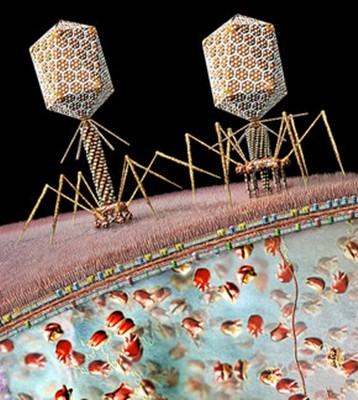Science and technology
科學技術
Microbiomics
微生物組學
A virus shield
病毒防護
Viruses help keep people disease-free
病毒能夠幫助人類免遭疾病
THE story of the microbiome—the community of tiny organisms that coexist symbiotically with people and other animals—gets weirder every day.
微生物組指的就是能與人類和其他動物互依共存的微有機體群,關于生物體組的傳言一天比一天古怪。
Until now that story, which has emerged over the past few years, has seemed one of friendly collaboration.
自其前些年出現至今,已經看作成一種友好互利的合作。
 In exchange for a place to live, bacteria aid digestion and help regulate their host's metabolism.
In exchange for a place to live, bacteria aid digestion and help regulate their host's metabolism.
只要它們寄住在寄主體內,細菌可以幫助寄主消化也可以調節寄主的新陳代謝。
The story's latest chapter, though, describes a different deal: between the animal host and viruses.
但是,關于生物體組的最新研究提出了一種不同的理論:在動物宿主和病毒的關系鏈之間還有細菌,
And in this deal, bacteria are the targets.
細菌是需要被消滅的。
Jeremy Barr of San Diego State University and his colleagues, who have just published their results in the Proceedings of the National Academy of Sciences, were intrigued by the high concentrations of viruses called bacteriophages in the mucus secreted by soft-tissue membranes ranging from the outer layers of sea anemones via the skins of fish to the mouths of people.
來自圣地亞哥分學的Barr及其同事,對叫噬菌體的一類病毒產生了濃厚的興趣,它廣泛存在于軟組織膜分泌的粘液中,不管是海葵的外表面、魚表面還是人類的口腔,他們將這一發現發表在《美國科學院院刊》上。
Such membranes are prime targets for pathogens, which is why so many people suffer from throat and lung infections, and upset guts.
這些軟組織膜就是病原體的主要存在區域,這就是為什么許多人會嗓子發炎、肺部感染和得腸炎。
Bacteriophages parasitise bacteria, a process pictured schematically above.
噬菌體寄生在細菌內,寄生過程難以用一兩句話說清楚。
Dr Barr wondered if they were actively working with their hosts to keep down the level of pathogenic bugs that might otherwise set up shop in the hosts' mucus membranes.
Barr博士覺得噬菌體或許可以幫助寄主降低致病菌的數量,防止病菌將在寄主的粘膜液中大量繁殖。
Regardless of which type of membrane they looked at, Dr Barr and his colleagues found about four times more phages per bacterium in the mucus than were in its immediate surroundings.
Barr博士和他的同事發現,無論在何種類型粘液中,每一個病菌對應噬菌體的數量要比粘液附近其他組織里的多四倍。
This suggested that phages are sticking specifically to mucus, and in an elegant series of experiments they found that this was true and that the thing on a phage which is doing the sticking is a “hypervariable” protein called Hoc.
這暗示噬菌體特定存在于粘液中,在一系列巧妙的實驗之后,他們發現確實是這樣并且發現噬菌體上存在一種稱為Hoc的高變蛋白,正是由于這種蛋白質才會使噬菌體特定存在粘液中。
Hypervariable proteins come in thousands of slightly different versions.
細分的話,高變蛋白有好幾千種。
The best studied is the mammalian antibody protein, immunoglobulin.
對這類蛋白研究最深入的要屬哺乳動物抗體蛋白—免疫球蛋白。
Each of the versions of this protein that exist in every individual is capable of locking onto and neutralising a different invading pathogen, by interacting with different molecules on the pathogen's surface.
人體內有各種高變蛋白的噬菌體,噬菌體通過識別不同細菌的表面分子,做到一種噬菌體只侵噬一種入侵細菌。
In phages, Dr Barr discovered, the various versions of Hoc stick to the varied branched sugar molecules characteristic of mucus.
Barr博士發現不同的HOC蛋白與不同的粘液特征性多糖分子的支鏈相結合。
That helps the phages, because their bacterial prey also accumulate in mucus, which is thus a rich hunting ground.
因為細菌的侵染過程也是發生在粘液中,這就為噬菌體提供了大量的寄生宿主。
And it helps the animal host, be that host sea anemone, fish or human being, by stopping any particular bacterial species running out of control—for if a species does start to multiply, which is a normal precursor to infection, there will be more phages around to attack it and multiply in their turn, bringing the uppity bug rapidly under control.
這也幫助諸如海葵、魚、人類一樣的動物寄主防止某種細菌大量繁殖,因為細菌要感染宿主就必須先大量繁殖,這樣周圍會聚集更多的噬菌體來侵噬它們,并且噬菌體開始繁殖,迅速控制住這繁殖快速的細菌的數量。
The phages are thus acting as a backup immune system for their hosts, and one whose mode of operation has a surprising parallel with that of the more familiar antibody-based system.
對于寄主來說,噬菌體屬于免疫系統的一部分,并且噬菌體的這種免疫系統與與它很相似的抗體免疫系統不相伯仲。











